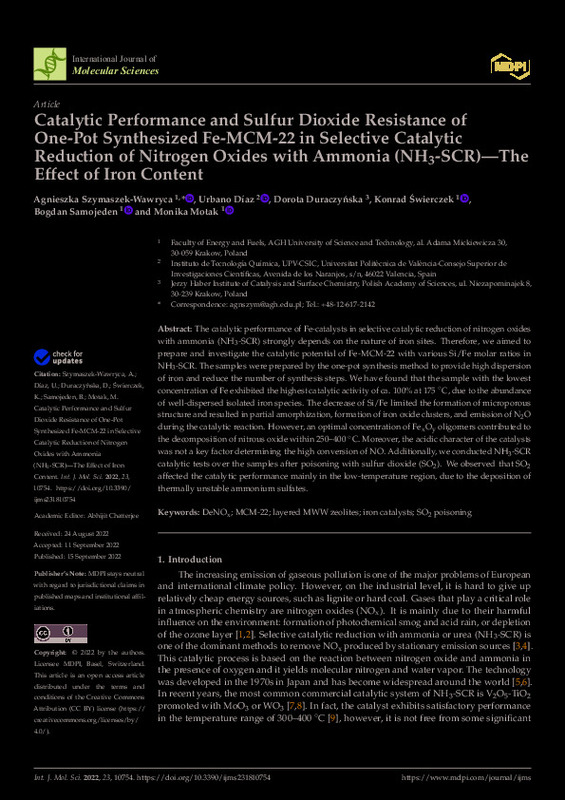JavaScript is disabled for your browser. Some features of this site may not work without it.
Buscar en RiuNet
Listar
Mi cuenta
Estadísticas
Ayuda RiuNet
Admin. UPV
Catalytic Performance and Sulfur Dioxide Resistance of One-Pot Synthesized Fe-MCM-22 in Selective Catalytic Reduction of Nitrogen Oxides with Ammonia (NH3-SCR)-The Effect of Iron Content
Mostrar el registro sencillo del ítem
Ficheros en el ítem
| dc.contributor.author | Szymaszek-Wawryca, Agnieszka
|
es_ES |
| dc.contributor.author | DÍAZ MORALES, URBANO MANUEL
|
es_ES |
| dc.contributor.author | Duraczynska, Dorota
|
es_ES |
| dc.contributor.author | Swierczek, Konrad
|
es_ES |
| dc.contributor.author | Samojeden, Bogdan
|
es_ES |
| dc.contributor.author | Motak, Monika
|
es_ES |
| dc.date.accessioned | 2023-05-25T18:01:09Z | |
| dc.date.available | 2023-05-25T18:01:09Z | |
| dc.date.issued | 2022-09 | es_ES |
| dc.identifier.uri | http://hdl.handle.net/10251/193600 | |
| dc.description.abstract | [EN] The catalytic performance of Fe-catalysts in selective catalytic reduction of nitrogen oxides with ammonia (NH3-SCR) strongly depends on the nature of iron sites. Therefore, we aimed to prepare and investigate the catalytic potential of Fe-MCM-22 with various Si/Fe molar ratios in NH3-SCR. The samples were prepared by the one-pot synthesis method to provide high dispersion of iron and reduce the number of synthesis steps. We have found that the sample with the lowest concentration of Fe exhibited the highest catalytic activity of ca. 100% at 175 degrees C, due to the abundance of well-dispersed isolated iron species. The decrease of Si/Fe limited the formation of microporous structure and resulted in partial amorphization, formation of iron oxide clusters, and emission of N2O during the catalytic reaction. However, an optimal concentration of FexOy oligomers contributed to the decomposition of nitrous oxide within 250-400 degrees C. Moreover, the acidic character of the catalysts was not a key factor determining the high conversion of NO. Additionally, we conducted NH3-SCR catalytic tests over the samples after poisoning with sulfur dioxide (SO2). We observed that SO2 affected the catalytic performance mainly in the low-temperature region, due to the deposition of thermally unstable ammonium sulfates. | es_ES |
| dc.description.sponsorship | Agnieszka Szymaszek-Wawryca gratefully acknowledges financial support from the National Science Centre Grant Preludium 19 (no. 2020/37/N/ST5/00186). Urbano Diaz acknowledges the support from Government of Spain through the project PID2020-112590GB-C21/AEI/10.13039/501 100011033. The research results presented in this paper by Monika Motak have been developed with the use of equipment financed from the funds of the "Excellence Initiative-Research University" program at AGH University of Science and Technology. Bogdan Samojeden's research was supported by the program "Excellence initiative-research university" for the AGH University of Science and Technology. | es_ES |
| dc.language | Inglés | es_ES |
| dc.publisher | MDPI AG | es_ES |
| dc.relation.ispartof | International Journal of Molecular Sciences | es_ES |
| dc.rights | Reconocimiento (by) | es_ES |
| dc.subject | DeNO(x) | es_ES |
| dc.subject | MCM-22 | es_ES |
| dc.subject | Layered MWW zeolites | es_ES |
| dc.subject | Iron catalysts | es_ES |
| dc.subject | SO2 poisoning | es_ES |
| dc.title | Catalytic Performance and Sulfur Dioxide Resistance of One-Pot Synthesized Fe-MCM-22 in Selective Catalytic Reduction of Nitrogen Oxides with Ammonia (NH3-SCR)-The Effect of Iron Content | es_ES |
| dc.type | Artículo | es_ES |
| dc.identifier.doi | 10.3390/ijms231810754 | es_ES |
| dc.relation.projectID | info:eu-repo/grantAgreement/AEI/Plan Estatal de Investigación Científica y Técnica y de Innovación 2017-2020/PID2020-112590GB-C21/ES/MATERIALES HIBRIDOS DE BAJA DIMENSIONALIDAD CON MORFOLOGIA, ESTRUCTURACION Y REACTIVIDAD CONTROLABLE PARA LLEVAR A CABO PROCESOS CATALITICOS Y NANOTECNOLOGICOS / | es_ES |
| dc.relation.projectID | info:eu-repo/grantAgreement/NCN//2020%2F37%2FN%2FST5%2F00186/ | es_ES |
| dc.rights.accessRights | Abierto | es_ES |
| dc.description.bibliographicCitation | Szymaszek-Wawryca, A.; Díaz Morales, UM.; Duraczynska, D.; Swierczek, K.; Samojeden, B.; Motak, M. (2022). Catalytic Performance and Sulfur Dioxide Resistance of One-Pot Synthesized Fe-MCM-22 in Selective Catalytic Reduction of Nitrogen Oxides with Ammonia (NH3-SCR)-The Effect of Iron Content. International Journal of Molecular Sciences. 23(18):1-32. https://doi.org/10.3390/ijms231810754 | es_ES |
| dc.description.accrualMethod | S | es_ES |
| dc.relation.publisherversion | https://doi.org/10.3390/ijms231810754 | es_ES |
| dc.description.upvformatpinicio | 1 | es_ES |
| dc.description.upvformatpfin | 32 | es_ES |
| dc.type.version | info:eu-repo/semantics/publishedVersion | es_ES |
| dc.description.volume | 23 | es_ES |
| dc.description.issue | 18 | es_ES |
| dc.identifier.eissn | 1422-0067 | es_ES |
| dc.identifier.pmid | 36142666 | es_ES |
| dc.identifier.pmcid | PMC9501588 | es_ES |
| dc.relation.pasarela | S\492899 | es_ES |
| dc.contributor.funder | National Science Centre, Polonia | es_ES |
| dc.contributor.funder | Agencia Estatal de Investigación | es_ES |
| dc.contributor.funder | AGH University of Science and Technology, Polonia | es_ES |








